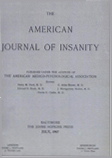THE ORGANIZATION AND ADMINISTRATION OF A STATE HOSPITAL INSULIN-METRAZOL-ELECTRIC SHOCK THERAPY UNIT
Abstract
Imperfect and unsatisfactory as it is at the present time shock therapy is economically, medically and socially justifiable. It is indicated in the treatment of mental disturbances unassociated with gross organic brain disease, where illness has been serious enough to lead to recent commitment to a state hospital, unless there are severe physical contraindications or unless there is a clear history of continuous illness outside of the hospital for several years. It appears to be a treatment of choice. From a five-year experience with this method in a large state hospital the authors conclude that the treatment is very conveniently and efficiently applied in a central unit where all patients are housed and where insulin, metrazol and electric shock therapy are given in parallel, with the idea of finding which treatment or what combination of treatments will produce the best result in each individual case. Costs per capita fall rapidly as the capacity of the treatment unit rises and it may be said that a unit with a capacity of 30 to 40 patients with two physicians is quite satisfactory from the operational point of view. Experience with the method and with choices of patients and therapies has somewhat the characteristic of an art. One cannot therefore expect good results from such an organization until it has had a year or two in which to develop its technique and experience. Finally, we feel that the treatment pays for itself in an improved parole rate, better public relations and intangible human values, both for the hospital staff and the community which it serves.
Access content
To read the fulltext, please use one of the options below to sign in or purchase access.- Personal login
- Institutional Login
- Sign in via OpenAthens
- Register for access
-
Please login/register if you wish to pair your device and check access availability.
Not a subscriber?
PsychiatryOnline subscription options offer access to the DSM-5 library, books, journals, CME, and patient resources. This all-in-one virtual library provides psychiatrists and mental health professionals with key resources for diagnosis, treatment, research, and professional development.
Need more help? PsychiatryOnline Customer Service may be reached by emailing [email protected] or by calling 800-368-5777 (in the U.S.) or 703-907-7322 (outside the U.S.).



